
SAFE & HEALTHY CHILDREN DESIGN FOR
A Study of Best Practices for School Safety, Mental Health, and Wellness
Watkins Elementary School | Washington, DC
AUTHORS
Ann Neeriemer, AIA, LEED AP Senior Associate
Robert Bell , AIA, ALEP, LEED BD+C Co-Managing Principal
CONTRIBUTORS
Emily Chmielewski , EDAC Senior Associate | Design Research Director
Sean O'Donnell , FAIA LEED AP Principal | K12 Practice Area Leader
Pallavi Puranik , RA, WELL AP, LEED GA
Kerrie Frymire, CPSM Senior Associate | K12 Marketing Specialist
Alex Alepohoritis Senior Associate | Graphic Designer
RESEARCH
Perkins Eastman is a global architecture firm dedicated to the idea that design can have a direct and positive impact on people’s lives. For almost forty years, our senior living experts have shared a passion for research and design that focuses specifically on improving the quality of life and level of care of older adults. We create places and spaces that put the user at the heart by employing best practices, sustainability, and a thorough understanding of our clients’ missions and operations. Our diverse teams partner with our clients globally to deliver next-generation projects suited to users who will live, work, play, learn, age, and heal within the environments we plan and design.
@2020 Perkins Eastman. All rights reserved.
CHILDREN DESIGN FOR
A Study of Best Practices for School Safety, Mental Health, and Wellness
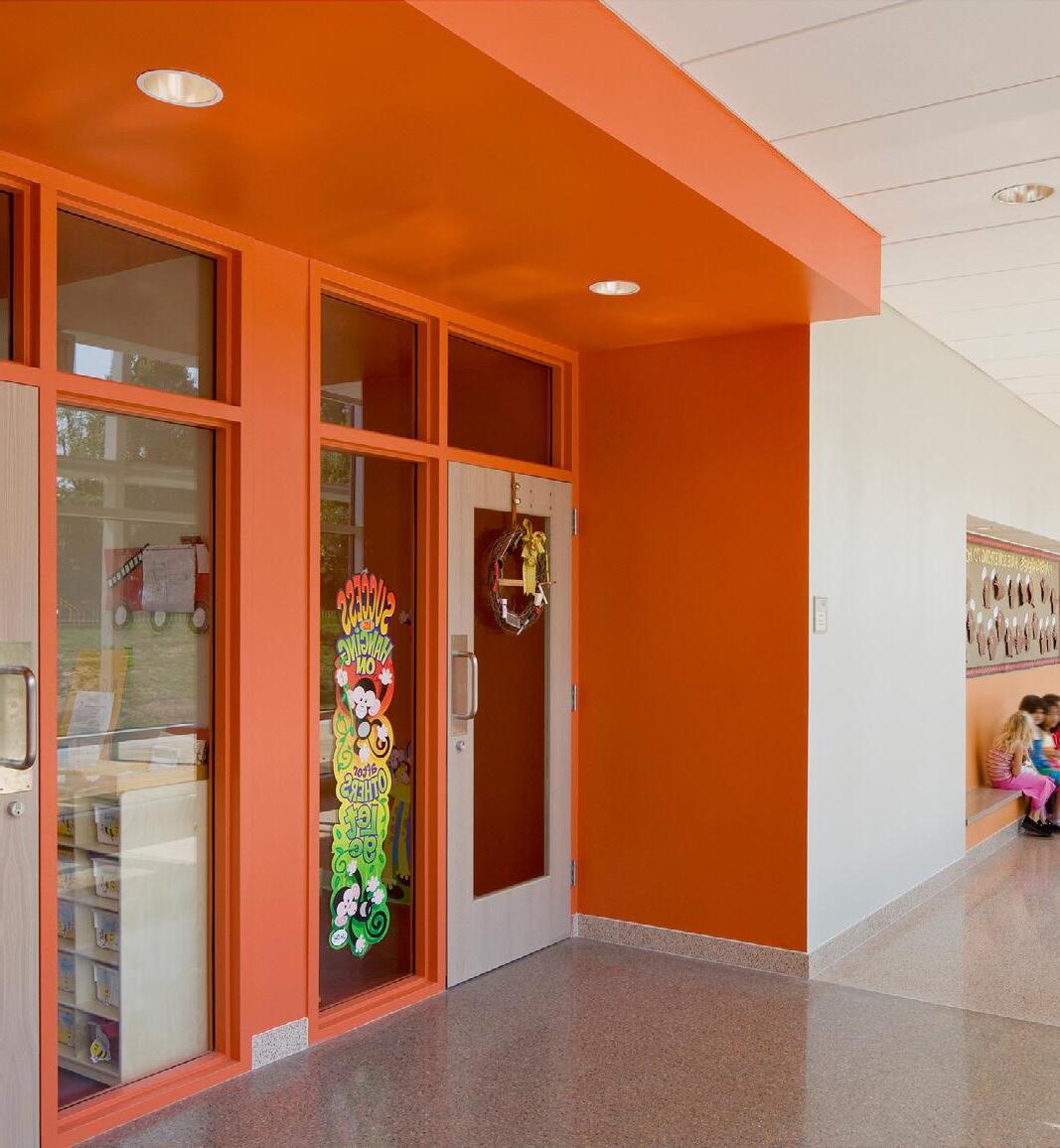 Stoddert Elementary School | Washington, DC
Stoddert Elementary School | Washington, DC
DESIGN FOR SAFE AND HEALTHY CHILDREN PERKINS EASTMAN

OF CONTENTS EXECUTIVE SUMMARY 1 STATISTICS AT A GLANCE 2 DEFINING THE PROBLEM 4 FOCUS ON PREVENTION 5 PUBLIC HEALTH APPROACH 10 SC HOOL CLIMATE AND CULTURE 11 PERKINS EASTMAN STUDY 13 A BALANCED APPROACH TO SAFETY 16 1. Addressing Transportation Safety 2. Create a Positive and Connected School Culture 3. Mental Health Support and Awareness 4. Physical Design, Systems, and Planning Features (including CPTED) 5. Safety Policy, Integrity, and Preparedness CONCLUSION 29
TABLE
EXECUTIVE SUMMARY
Public media has been flooded with stories of gun violence in schools. As important and tragic as these events are, they sometimes overshadow equally concerning– and more frequently occurring– incidents such as self-harm, depression, bullying, substance abuse, and assault that occur in schools every year.
Collectively, these events challenge schools and designers to find appropriate responses within often passionately held, and diametrically opposed, extremes: hardening versus softening, intruders versus insiders, locked-down versus open and transparent. Our team has studied factors that contribute to the safety and security of schools and the impact of various programs, policies, and design features on school safety and security, as well as occupant well-being.
Our hypothesis was that students learn better and are more successful when they feel safe and connected.
What we learned in our research is that the feeling of safety is intrinsically connected to a sense of belonging, mental health, and well-being. Even a glancing review of the most publicized and horrific school incidents reveals that mental health and social-emotional factors are key contributing factors in every event. We are interested in understanding how to prevent tragic events from occurring in the first place, not just best practices for lessening their impact.
Our study gathers data and research from many sources to understand contributing factors in child development to their mental health, well-being, and safety. This paper will discuss overarching themes recognized from the research and conclude with a balanced approach to address the safety, mental health, and wellness of students and adults in schools.
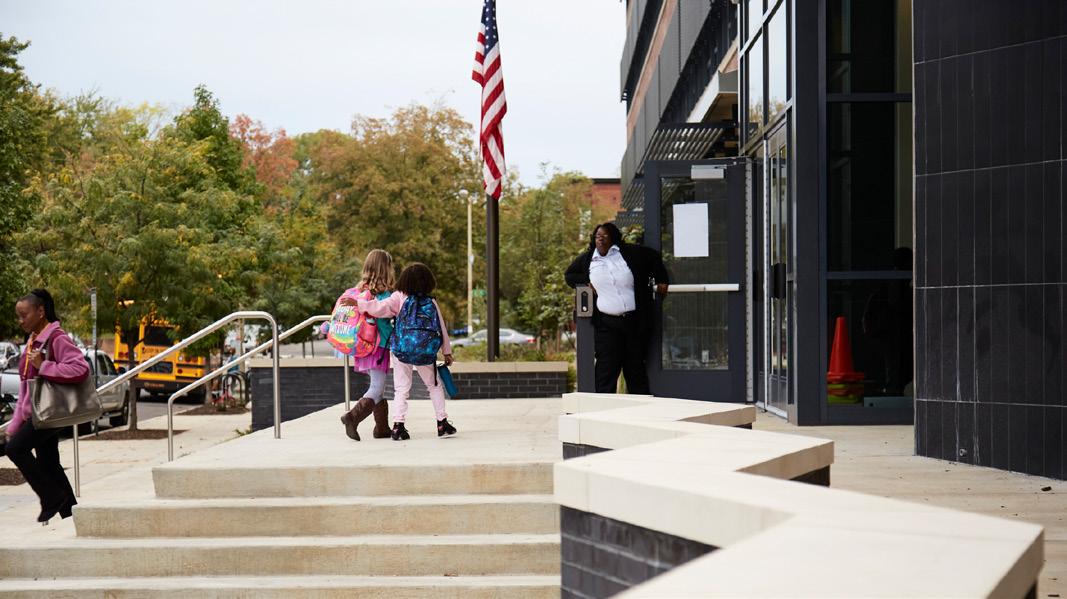
Watkins Elementary School | Washington, DC 1 DESIGN FOR SAFE AND HEALTHY CHILDREN PERKINS EASTMAN
STATISTICS AT A GLANCE
What are the real facts about violence and safety issues in schools?
With so much conversation and sensational media coverage, it’s easy to be overwhelmed and misguided regarding the actual risks. Many well-established organizations have tracked and compiled data regarding various types of school safety issues from bullying and assault to thoughts of suicide and actual fatalities. Included here are statistical excerpts of the data that helps put the real risks and dangers into perspective.
Statistically speaking, gun violence is a rare event in schools. In the “2014 Report of Relative Risks of Death in U.S. K-12 schools” published by Safe Havens International,1 information was pulled together from a variety of national sources and extrapolated to statistically complete the cause of all school related deaths in a time period of 1998 to 2012. There were 6 findings in this report as follows:
1. Active shooter incidents are not the leading threat for fatal incidents that schools face.
2. Active shooter Incidents in schools are not happening more frequently.
3. Active shooter incidents should not be the primary focus for a school’s prevention and mitigation and emergency preparedness efforts.
4. More focus needs to be given to school transportation-related safety.
5. More focus needs to be given to targeted homicides and suicides in schools.
6. From 1998 to 2013, there were nearly as many school tornado-related fatalities (22) as gangrelated fatalities (24).
The report concludes that it is important to do a datadriven risk assessment before a school considers which safety approaches work best for their school.
Figure 1 charts data within the 2014 Report of Relative Risks of Death in U.S. K-12 schools report and shows that if we are focused on saving lives, perhaps much more attention should be given to transportation safety, rather than active shooters. Certainly targeted homicides and suicides warrant more attention, but specifically, attention to the underlying causes and contributing factors that lead to violence and feelings of hopelessness, depression and suicide. While transportation and homicides are the leading types of fatalities, it is important to recognize that they are also statistically rare in schools.
Accidents Severe Winds Active Shooter Unknown Suicides Homicides 40% 2% 2% 5% 8% 10% 33%
Figure 1 - School Fatalities Transportation
Related
2
When compared to overall transportation fatalities, the number that are school-related transportation fatalities is very low. The school transportation related number includes all school related travel, not just occurring on a school campus. (NHTSA)2
A 2015 study 6 looked at homicide incidents data recorded in the Federal Bureau Investigation’s National Incident Based Reporting System (NIBRS) for 37 states. Over the recorded period, only 0.3% occurred on school properties.
This diagram shows the comparison of youth behavior survey data for the year 2017 from the CDC Youth Risk Behavior Survey report.5 The data clearly shows that mental health and bullying are top safety concerns, while concerns about weapons are among the lowest reported.
As noted by the UVA Curry School report, gun violence is a serious problem in the United States, but it is less likely to occur in schools than almost any other location. The gun homicide rate is far higher in the United States than other developed nations, and is at least seven times higher than rates in many peer nations.3
If we consider the more common risks, those that affect the majority of students on a daily basis, we get a very different picture. The Center for Disease Control’s Survey from 2017 asked what the greatest behavioral risks are for school aged youths.
0 5 10 15 20 25 30 35 Weapons Safety Absense Forced Sex Violence–Sexual vs. Dating Drug Use–Injected vs. Missuse Suicidal–Attempted vs. Feelings Persistent Sadness/ Hoplessness Bullied–Social Media vs. At School Social Media14.9 At School19 Attempted7.4 Missuse14 Feeling17.2 2 Total 33.9 Total 31.5 Total 24.6 Total 16 Total 14.9 Total 7.4 Total 6.7 Total 6 Sexual6.9 Dating8
0 200 400 600 800 1000 1200 1400 School Transp. Related Total Transp. Fatalities 1282 115
Figure 2 - Transportation Fatalities Overall
Figure 3 - Locations of Homicides Overall
0 2000 4000 6000 8000 10000 Residence Street Parking Lot/Garage Outdoors Restaurant/Bar Store/Gas Station Public Building Hotel/Motel School 9847 4455 1209 629 533 492 288 211 49
3 DESIGN FOR SAFE AND HEALTHY CHILDREN PERKINS EASTMAN
Figure 4 - Youth Risk Behavior Survey
The responses clearly focused heavily on bullying, depression and suicide, with drug use and sexual assault or violence ahead of weapons. Understanding these concerns should redirect our attention to design and cultural aspects that address these issues, which may be different than what might be considered if we only think about shooting events.
With each of these pieces of the puzzle, it’s important to look at the school statistics relative to other locations. In each case, you can see that schools are very safe environments overall compared to other locations, including homes.
DEFINING THE PROBLEM
While active shooter incidents are not the primary threat faced by schools, the high emotional impact of these incidents distorts the public perception regarding their likelihood. The fear of school violence since the late 1990s has given American schools harsher discipline policies, such as zero tolerance, increased presence of armed officers in schools, and increased costly detection systems. Expenditures on these hardening measures can limit funds available for student support and preventative measures, such as school psychologists and counselors.
Decisions driven by fear often cause more harm than the situations they are supposed to help avoid, as is shown by the zero tolerance policy which did little to help schools, law enforcement, and mental health

experts to identify deeply troubled students and to stop the violent incidents from escalating. These have resulted in unintended consequences.4 It is more important than ever to put our fear into context as not to paralyze our ability to see the whole picture and, rather, to come up with a balanced approach to address this complex and multi-faceted issue.
In his book School Violence: Fears versus Facts, Professor Dewey Cornell says, “The question, ‘how safe are our schools?’ can be addressed in multiple ways, but answers should be based on facts rather than images of mass shootings. Although some schools are less safe than others, the facts consistently show that American schools are remarkably safe.” Professor Cornell further cautions that it is important to take an objective, fact-based approach to decisions related to safety in our schools. Active shooter incidents are rare but they have the power to distort public opinion and redirect valuable resources and attention from other more common safety concerns in schools.
Schools have finite resources that must be allocated wisely. It is important to step back and use datadriven risk assessment to prioritize the use of funds more effectively, addressing safety with a structured and comprehensive approach. It is essential to consider the whole child – physical as well as emotional safety of a student – to carefully weigh the direct and indirect effects of all decisions.
AWARENESS HEURISTIC
David Ropeik, Harvard instructor and consultant in risk perception and risk communication, describes Awareness Heuristic – a term in cognitive sciences – as “a mental shortcut we use to quickly assess the likely frequency of things we don’t know much about, the more readily an event leaps to mind from our memory, or the more persistently it’s in the news, the more emotionally powerful and probable it feels.”7 This is especially true regarding any decisions around safety of our students with respect to gun violence.
4
Charter Oak International Academy | West Hartford, CT

RESEARCH FRAMEWORK
The balanced approach we present here derives its framework from the four steps of Public Health Approach and the “Call for Action.”23 Accordingly, the first step in our research was data collection. This was done through literature research and review of nationally available statistics. The literature research topics included, but were not limited to: brain development in children, adverse childhood experiences (ACEs), whole child approach, public health approach, stress and its relationship to child development, resilience, as well as the history and context of violence in schools, youth risk behavior trends, and school climate.
In addition to the literature research, we also conducted surveys and interviews with schools in Massachusetts and North Carolina (refer to the Perkins Eastman Study section). The first step helped us further define the issue and figure out risk and protective factors, which is also the second step of a public health approach. The third step is to develop interventions, which is what we define as a “Balanced Approach” to safety through a lens of architectural interventions. Architecture alone cannot resolve any of the issues faced by schools but if the variety of school stakeholders and designers come together, the school design can really reflect and reinforce the school vision and, hopefully, make school a safe abode for all its occupants.
FOCUS ON PREVENTION
A comprehensive approach to safety requires an understanding of the underlying causes for these incidents.
The number one concern cited by teachers and school administrators is the state of mental health, not just of the students, but also their families and the community at large. To address this, it’s important to understand what the drivers are leading to poor mental health, and challenges students face such as unhealthy stress levels and depression. These challenges affect not only the student experiencing them, but also their peers.
MENTAL HEALTH AND THE IMPACT OF STRESS ON THE BRAIN
The World Health Organization (WHO) defines mental health as “a state of well-being in which every individual realizes his or her own potential, can cope with the normal stresses of life, can work productively and fruitfully, and is able to make a contribution to her or his community.”8
A key area of our research was to understand how the physical and social environment of schools impact the student’s developing brain and body. The US Center for Disease Control (CDC) offers a large body of knowledge and deep research illustrating the negative impact of adversity on the development of young learners. This research explores the impact of childhood trauma on both physical and cognitive development, and identifies various adverse childhood experiences or “ACEs” which are potentially traumatic events that occur in childhood (defined as 0 to 17 years). The research also looks at environmental aspects that can undermine a child’s sense of safety, stability, and bonding.9
Exposure to these stressors in childhood is associated with large increases in risk for heart disease, cancer, COPD, and even Alzheimer’s disease. Of the 10 primary ACEs identified, 61% of the population have experienced at least one. 13% have experienced 4 or more. That percentage is often not evenly distributed, instead being concentrated in urban schools, and others with high
5 DESIGN FOR SAFE AND HEALTHY CHILDREN PERKINS EASTMAN
populations living in poverty. In fact, 1 in 7 children experienced child abuse or neglect in the last year.10
Children in poverty are far more likely to have these adverse experiences, including death or incarceration of a caregiver or loved one, domestic violence, physical or sexual abuse, neglect, addiction, mental illness, among others.9
Children who have had these frightening or threatening experiences, or repeated exposure to unstable environments, often exhibit what’s referred to as a “symptom cluster.” Children, and their still developing brains, do not yet have the skills to process these negative experiences. These children struggle with relationships, learning, trust, and attention span –interrelated challenges that can reinforce each other, effectively disabling children from the ability to thrive. What exhibits as behavioral issues in the school and classroom is often a direct result of these challenges and, therefore, disciplinary action, particularly exclusionary discipline, only serving to reinforce this cycle rather than to break it.
High levels of stress, which produces cortisol, can have significant physiological impacts, including changes in brain development, immune system development, and hormonal systems. This impact to the structure of the brain affects children’s attention and behavioral control, and their ability to engage in learning.11
This may seem like a big topic to talk to children about, but it’s actually very useful to teach students about how their brains work. Turnaround for Children, an organization founded to equip educators to address the impact of stress and trauma, does exactly that. While it’s good to understand the why, teachers and other school staff need support and tools to implement change. During our interview with leadership of the Dennis-Yarmouth Intermediate Middle School, superintendent Carol Woodbury shared a story with us about a 2nd grader whose mom was trying to help him put on his coat and shoes, during which time he had a little meltdown. So he got up and said, “Just a minute,” and went to his room. When he returned, he said, “I’m sorry Mommy, but my amygdala was hijacked.” Teaching kids that the way we feel is sometimes about what’s going on inside of our bodies and that there are ways we can take care of that, helps them learn to control their responses.12 “Helping children understand that their brains can grow, change, and heal empowers them to transform their own growth and development. If [children] are given a chance to make better choices when they act out, rather than being punished, they learn that they can exert selfcontrol. That, in turn, readies them to learn.”11
We’ve got to own it, and acknowledge that trauma is everyone’s problem. This is not a poverty problem. This is not a race problem. This is a function of human biology. It is the way all of our bodies are wired. And now we can use this science to improve outcomes for everyone.
- Dr. Nadine Burke-Harris, CEO of the Center for Youth Wellness
Early Death Disease, Disability, and Social Problems Adoption of Health-Risk Behaviors Social, Emotional, and Cognitive Impairment Disrupted Neurodevelopment Adverse Childhood Experiences Conception Death Figure 5 - Mechanism by Which Adverse Childhood Experiences Influence Health and Well-being Throughout the Lifespan
6
Graphic based on Adverse Childhood Experience chart by the National Center for Injury Prevention & Control, Violence Prevention Division, a subdivision of the Centers for Disease Control (CDC)

A 2010 study by the National Institute of Mental Health (NIMH) recorded student perceptions of safety in the school and the neighborhood, as well as objective measures of neighborhood violence, and compared these to test scores among 3rd to 5th graders in Baltimore. The results of both showed an increase of violence was directly related to a decrease in test scores. However, after controlling for poverty measures, only the perceived violence still equated to lower academic performance. Poverty may be a more important predictor of academic achievement than neighborhood violence. The bottom line is that when students are fearful and constantly worried, whether about their safety or their next meal, their ability to focus on academics is compromised.13
Creating an environment where children feel safe is important, and more effective. Chaotic school environments can reproduce the stress that children see at home or in their community.11
MENTAL HEALTH AND CHILDREN
Today, as many as 1 in 5 students show signs of a mental health disorder.9 Children, as early as preschool, are being prescribed medication for ADHD and depression at alarming rates.17
The Whole Child Network (an initiative of the Associate for Supervision and Curriculum Development) puts the challenge in this way: “Each child, in each school, in each of our communities deserves to be healthy, safe, engaged, supported, and challenged.”14 Whole child development requires the integration of cognitive, social, and emotional processes. Cognition and emotion have historically been thought of separately, but they are inextricably linked.
Another key idea to focus on is how connected a student is to their peers, community, and surroundings. Disconnection from other people, from nature, and from a sense of status or respect all correspond with higher levels of stress and depression. Experiencing humiliation and witnessing inequality leads a person to focus more on on their own status, leading to feelings of anxiety.15 So an important factor to consider is how disparities in facilities and access to quality environments and resources influence kids. How can we best design for dignity?
It’s important for students to have a sense of a hopeful and secure future. Consider what the impact is on children when society has low expectations of them. The Pygmalion Effect – that high expectations lead to improved performance – has proven true time and time again, as has the opposite concept, known as the Golem Effect.15
Most school shooters are current or former students, and the median age is just 16 years old. They are typically children who felt neglected, worthless, or

6 7 DESIGN FOR SAFE AND HEALTHY CHILDREN PERKINS EASTMAN
Source: McEwan18 Figure
outcast.16 While school shootings are horrific, we can’t forget that many other types of incidents occur on campuses every day, such as bullying, fights, and sexual abuse.
The Centers for Disease Control and Prevention indicates that the suicide rate among children ages 10 to 17 increased by 70% between 2006 and 2016. Approximately 72% of children in the United States will have experienced at least one major stressful event — such as witnessing violence, experiencing abuse, or experiencing the loss of a loved one — before the age of 18.
Suicide is the second leading cause of death for 10 to 24 year olds, and 8.2 million children are reported to be sexually exploited each year.
Every community has limited resources of time, money, and energy. As we think about expending those resources, it’s important to address all of these issues to create safe schools.
As noted above, cognition and emotion are inextricably linked. In our interview with Dr. Jamie Johnson, the principal of North Buncombe Middle School in North Carolina, we heard about how that school is implementing this concept successfully:
“We are going to love our kids first and teach them second. This means making sure teachers know each student – what do they like, what do they do outside of school? This leads to mutual support.” As Dr. Johnson introduced this approach, she found that most staff were on board with the idea, but implementation and responsibility of what that means was sometimes more challenging. “For example, teachers are expected to call parents and communicate with them, tell them something positive about their kid. Teachers can’t just not engage. It takes work. But through the course of the year, teachers saw the difference it made, that when they took the time, the kids performed better and were more engaged, and parents were more engaged as well.” That success has led to further buy-in across the school staff.
To address the whole child, we must provide both physical and emotional safety. Building these emotionally safe environments can actually prevent a student from becoming a threat.
THE IMPACT OF HARDENING & SOFTENING MEASURES ON STUDENT DEVELOPMENT AND SCHOOL CULTURE
When major incidents occur, families and communities often want schools to take action immediately, just to do something to indicate they are addressing the issue. Often that something is some sort of “hardening” measure such as lock-down door hardware – in part because they are quick to implement, and also because it is typically more visible to the community. By contrast, “softening” is focused on creating positive environments and prevention measures, which can be harder for those outside of a school to see and understand.
According to two separate 2016 Department of Justice reports, there is no independent research supporting claims that hardening features such as bullet resistant glass and weapons detection will save lives. “If we’re just expecting technology to solve all these problems, I think we’re going to fall short,” said Ronald Stephens, Executive Director of the California-based National School Safety Center, created originally as a federal program under the Reagan administration. “And we may not like the climate we create.”19 Indeed we know that a school climate has a significant impact not only on school safety, but all sorts of student outcomes
It is also important to understand the effects that hardening measures can have on kids. Hardened, fortress-like school buildings often reinforce the stressors or trigger previous trauma -- acting as a constant reminder to kids to stay on alert – exactly the opposite of what we would want for our children.
In her book, The Deepest Well: Healing the Long Term Effects of Childhood Adversity, Dr. Nadine Burke
Harris20 includes an example to help us understand what happens in our bodies during a moment of high stress:
“Imagine you are taking a walk in the woods and you encounter an angry grizzly bear. When you see that bear, your body reacts immediately – flooding your system with adrenaline and cortisol, so your pupils dilate, your heart races, and you are ready to either fight or run from that bear.
8
But fighting the bear wouldn’t be a very good idea, because you’ll probably lose. And that is why the alarm center in your brain, your amygdala, sends neurons to shut down your prefrontal cortex – the part of your brain that regulates executive functioning. So basically your body is saying, “we’re not going to think right now, right now is the time to react.”19
Now if this happens once in a while, maybe that’s OK. But what happens when it occurs over and over again, especially when you are a child, and your brain and body are just developing?”10
This is what it can feel like to children who are constantly experiencing stress at home or in their communities. That constant stress affects brain development, immune system development, and hormonal systems.
Opinions regarding school resource officers (SROs) are widely varied, and the differences lend important considerations to the topic. Some schools we interviewed reported that the SRO was an engaged and important addition to a positive atmosphere in their schools. These individuals were genuinely engaged with students, building relationships to support staff and enabling students to feel comfortable reporting their concerns. However, other communities recognize that a person appearing as a police presence can lead to higher likelihood of bad behavior in school being criminalized. Yale Medical
The spate of gun violence in our schools is a public health issue—both tragic and preventable. Therefore, SSWAA supports “school softening” not “school hardening.” We prefer to focus on prevention ... having caring, highly-trained adults— including school social workers, school psychologists, school counselors, school nurses, and other specialized instructional support personnel —in every school. It means having a strong multi-disciplinary team in place to develop a positive school environment for every student.”
- School Social Work Association of America to the Federal Commission on School Safety
Group psychiatrist, Paula Zimbrean says, “The message to kids is that school is a dangerous place and they have to be protected. School should be a place to grow up, to learn, and to have fun.” Child psychologist Illisse Perlmutter iterates, “Personally, I think it gives a mixed negative message to youngsters that their school is not safe and they need firearms to keep safe.”21 Each school and community must make this decision carefully and thoughtfully with regard to the specific culture that exists in both their school and wider community.
The vast majority of our research suggests that real solutions lie in what are often thought of as “soft” responses -- such as investment in counselors, integrated transparency, and student support programs -- as the more comprehensive and effective solutions to all of the types of safety challenges schools face. However, it’s clear that technology can also be successfully included in a comprehensive safety strategy for schools. Clear protocols, training, enforcement, and positive culture are logically supplemented and supported by basic features such as locked doors and entry surveillance. The idea of choosing hardening or softening is a false dichotomy. Each school and community must make decisions that best serve their students and neighborhoods based on many unique characteristics. It is important that leadership approach this thoughtfully, and do not make quick decisions driven by a salesperson. Many gadgets and technologies are available on the market now that, at best, are a waste of funds and, at worst, actually make schools less safe by creating fire and other safety hazards.
In this paper we present a lot of background information in hopes that a deeper understanding of the issues and causes of violence in schools can lead to smarter decisions. It is the job of each of us to listen carefully, to share ideas, to educate each other and, ultimately, to make decisions that hold close the desire we all share of keeping our school children safe and healthy. Having done this research, we feel strongly that a comprehensive and balanced approach to school design will provide not only safe environments, but places that hold the next generation in high esteem, encouraging positivity and healthy individuals and communities.
9 DESIGN FOR SAFE AND HEALTHY CHILDREN PERKINS EASTMAN
PUBLIC HEALTH APPROACH
A public health approach provides us with a framework for how to comprehensively address and prevent violence in schools. While the public health approach has its origins in disease control, over the last four decades, similar principles have been applied to violence reduction. The recognition of violence as a health issue is founded on an understanding of violent behavior as it arises from contextual, biological, environmental, systemic, and social stressors.22 The public health approach to violence focuses on prevention by addressing the known risk factors.
GATHER RELEVANT DATA
IDENTIFY RISK & PROTECTIVE FACTORS
What is the problem?
What are the causes?
There are four steps to the public health approach for violence reduction:
STEP 1: Gather relevant data to define the problem
STEP 2: Identify risk and protective factors
STEP 3: Develop interventions to increase protective factors and reduce risk factors
STEP 4: Implement the interventions on a large scale to provide benefit to a broad section of society for collective benefit
DEVELOP INTERVENTION IMPLEMENTATION
1 2 3 4
What works?
How do you do it?
Following the Parkland School shooting in 2018, a group of researchers came together to create a “Call for action to prevent gun violence in United States of America.” Based on a public health approach, this call to action emphasized that focusing simply on preparing for shootings is insufficient. A change of mindset and policy from reaction to prevention is required. The call for action had three levels of intervention – school climate, mental health, and threat assessment 23
SCHOOL CLIMATE MENTAL HEALTH THREAT ASSESSMENT
▪ Physically and emotionally safe
▪ Positive school environments (protects from bullying, discrimination, harassment, and assault)
▪ School and communitybased mental health services
▪ Reform discipline (restorative justice and social emotional leaning)
▪ Threat assessment teams (including principal, staff, mental health, and law enforcement partners)
▪ Practical channels of communication for persons to report potential threat
Figure 8 - Change From Reaction to Prevention
Figure 7 - Public Health Framework
10
SCHOOL CLIMATE AND CULTURE
School climate and culture are often used interchangeably, however, “school climate” refers to individual experiences and feelings, while “school culture” refers to long-term physical and social environment, as well as shared values or beliefs. The National School Climate Center (NSCC) has proposed thirteen dimensions for School Climate, categorized in six major areas as shown below.
The thirteen dimensions acknowledge that a sense of security fosters student learning and that student and staff relationships affect school climate.
A student’s feeling of connectedness to their school results in better health and academic outcomes and reduced levels of aggression. The physical characteristics of a school building -- such as lighting, acoustics, cleanliness, maintenance, and environment -- have also shown positive correlation with academic performance.24
Administrators are crucial in setting the tone for school climate with clear vision and accessibility. Leadership and staff need to come together as a collective whole for the vision to work.
In her testimony presented to the Sandy Hook Advisory Commission (SHAC), Dr. Marissa Randazzo discusses situational awareness: “By creating school environments that enhance the opportunity for faculty, staff, and other students to observe student behavior, and by training faculty and staff to be attuned to changes in student behavior, information about a student’s ideas and plans for violence may potentially be observed or discovered before harm can occur. Situational awareness is a fundamental
tool in behavioral observation, condition assessment, first response determination and management, and incident command control measures.”
Dr. George Sugai, an expert in school climate and student behavior at the University of Connecticut Neag School of Education states, “The most important thing parents and educators can do… is to make sure that they are involved with their children, to prevent a sense of isolation and the breakdown in communication channels that can lead to violence.” He emphasizes that respectful, collaborative relationships are essential to create greater situational awareness, which is ultimately key to creating accepting, inviting, and safe school environments.25
BENEFITS OF POSITIVE SCHOOL CLIMATE AND CULTURE
A vast amount of research supports the idea that positive school climate has many benefits for school systems. The positive benefits affect students, staff, families, and the local community. Benefits range from improved academic achievement, personal and mental health, and relationships; as well as reduced bullying, victimization, suspension, drop out, and teacher turnover.
Achieving a positive school climate enhancement is not a simple or quick task, but it is a crucial piece of school improvement and can have profound effects on both student well-being and academic success.
National School Climate Center (NSCC) has proposed the 13 Dimensions of School Climate which are categorized into six major areas:
Safety Teaching & Planning Interpersonal Relationships Institutional Environment Social Media Leadership & Professional Relationships
11 DESIGN FOR SAFE AND HEALTHY CHILDREN PERKINS EASTMAN
Figure 9 - Dimensions of School Climate
Superintendent Carol Woodbury and Assistant Superintendent Ken Jenks of the Dennis-Yarmouth Regional School District both emphasized the importance of school climate and providing kids with guidance about how to behave. “If kids could do it they would. If they aren’t doing it (whatever “it” happens to be) then we need to teach them,” Woodbury says. It’s that simple. Help kids understand what being respectful means when they are in the classroom and on the playground.
Using principles and guidance from the Positive Behavioral Interventions and Support (PBIS) framework, they run through scenarios with students: What is the appropriate response to this situation? How do you do this? How to you address these folks who are maybe not being respectful? “Explicit instruction helps everybody,” Woodbury emphasizes. “Kids are paying attention. And when you create that kind of environment, kids feel safer, and also feel more confident in reporting something they are uncomfortable with.” Jenks concludes, “An effective school design supported by a positive school culture and climate is the key to a safe school.”12
Various Programs
There are many frameworks available to help schools and communities deploy a public health approach. Schools nationwide are engaging with these structures to proactively address challenges and create positive cultures.






▪ Positive Behavioral Interventions and Suppo rts (PBIS)
▪ Multi-Tiered System of Supp ort (MTSS)
▪ Compassionate Schools
▪ Calmer Choice
▪ Too ls of Mind
▪ Positivity Project
▪ Social Emotional Learning (SEL) by CASEL

12
MTSS
PERKINS EASTMAN STUDY
Apart from the literature review and gathering of existing statistics, our study included a survey and interviews with a handful of schools, allowing us to test for alignment with our broader findings. The study focused on middle schools, as research studies have shown that middle school is an especially challenging time for students. The transition from a more homelike environment of elementary school is difficult for many, and coincides with a particularly challenging growth in social and emotional development processes occurring within this age group. For instance, the Gaggle Student Safety 2018-2019 report indicates that bullying is 118% more prevalent among middle school students.26
Our initial goal was to survey and interview schools from urban, rural, and suburban school districts to tease out any similarities or differences in the approach to safety in these three cohorts. In the end,
though, our study consisted of three schools: two suburban schools in Massachusetts and one rural school in North Carolina. The urban school district was unable to participate at the time but we continue to follow up with them for possibilities of future studies.
The schools were selected based on our prior personal or professional relationships. The school interviews were not meant to be comprehensive in any way, but were seen as opportunities to share some unique stories of how schools in different settings think about and address safety and security concerns.
Our study consisted of three parts:
1. Staff survey: 141 teachers participated in the survey (see Appendix A for staff survey questions).
2. Interview with school leaders and safety experts: Interviewed 4 school leaders (see Appendix B for interview questions).
The graph below lists 10 safety concerns along the bottom. Each teacher prioritized the concerns from highest to lowest, ranking them 1 through 10. The bar chart is segmented and shaded incrementally from darkest to lightest, representing highest to lowest priorities with the number of votes indicated within each segment. The darker the bar, the greater the concern expressed. For example, Mental Health concerns received 40 votes as the top concern and 11 votes as the number two concern, while Bullying Online received only 7 votes as the top concern, but 16 as the number two and 27 as the number three concern.
Mental Health BullyingOnline BullyingIn Person Substance Abuse Influence of Media Violence Accidental Injury- On Campus Accidental Injury- Off Campus Sexual Assault & Harassment ViolenceOff Campus ViolenceOn Campus
The number shown on each bar represents the number of respondents who ranked that as their top concern. MENTAL HEALTH BULLYING – ONLINE BULLYING – IN PERSON SUBSTANCE ABUSE INFLUENCE OF MEDIA VIOLENCE ACCIDENTAL INJURY – ON CAMPUS ACCIDENTAL INJURY – OFF CAMPUS SEXUAL ASSAULT AND HARASSMENT VIOLENCE – OFF CAMPUS VIOLENCE – ON CAMPUS GREATEST RISKS OR THREATS TO STUDENTS Series1 Series2 Series3 Series4 Series5 Series6 Series7 Series8 Series9 Series10 40 7 8 6 4 5 1 1 3 3 13 DESIGN FOR SAFE AND HEALTHY CHILDREN PERKINS EASTMAN
Figure 10 - Safety Concerns of Teachers
3. Interview with students: Interviewed 8 middle school students (see Appendix C for student interview questions).
DATA FROM PERKINS EASTMAN STUDY
The staff survey consisted of 25 questions, including what individuals felt were the highest risks and threats, what safety measures the school had in place, what types of discipline and support services they offer, and how the building design contributes or detracts from safety. Figure 10 depicts the results, and the findings largely illustrate concerns in parallel with the CDC youth behavior risk survey and other studies, further corroborating the national emphasis toward mental health issues, bullying, and substance abuse.
Our small sample did show a minor variant between the suburban and rural schools, with substance abuse ranking slightly higher than bullying in the rural school. Mental health, however, remains the top concern by a margin of almost 6 times any other topic. Next in line is bullying (particularly if combining online and inperson) concerns of schools when it comes to safety and well-being of their students. Violence, both on and off campus, was of low concern as reported by the teachers we surveyed.
It is important to note that violence numbers were low also due to the locations of these schools being in low crime neighborhoods. The concern for violence off campus can be considerably higher in urban school districts. For example, at least 84 school campuses in the District of Columbia experienced one or more gunshots within 1,000 feet of their campus during the school day in the 2016-2017 school year, according to data gathered by the ShotSpotter gunshot detection service and analyzed by Guns & America.27
Much of the information gathered from our interviews is integrated into the previous report sections and our recommendations for a balanced approach. Overall, something that was emphasized in our interviews as well as our literature research is that changes and effective policies are systemic. No single gadget, technology, or policy is the answer. Using those things as tools to support an overall approach to positive culture is the most effective solution, and sometimes that systemic shift is slow to implement and may be difficult to recognize.
A great example of this was shared by the principal of North Buncombe Middle School in North Carolina. Early in her tenure, Dr. Jamie Johnson made a shift to a more heterogeneous schedule at the school. Previously students were “tracked” (generally based on academic performance) which meant that the same set of kids are with each other for all of their classes. Students were very aware of which track they had been placed in, defining them in specific ways that were sometimes limiting, or pre-defining expectations for students. Dr. Johnson purposefully moved to a mixedgrouping schedule, so students could have classes with a different set of students in each period of the day. After implementing this change, growth targets that had not been met in years were now being achieved. This helped significantly with staff buy-in, however it also meant more or different work for the teachers, so it has been a big transition that takes some time to adjust to. This move toward ‘academic diversity’ has also been a proactive approach to bullying. It is much more difficult for a child who has to tolerate spending their entire school day, five days a week, with a another student who is unkind or taunting, than if that child only has to interact with the difficult classmate for one period a day. This also gives all students a chance to see themselves in different academic contexts, and find their strengths as individuals instead of, for example, being the “best of the slow class” or the “worst of the honors class.” This development of self-image and contextualization is especially important at this critical age for personal growth.
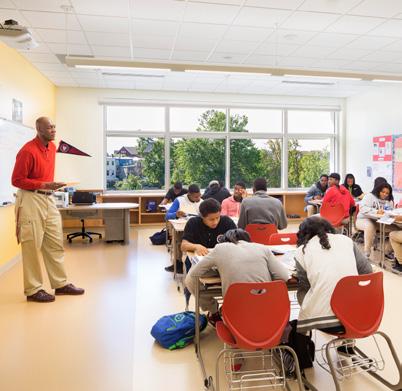
14
Dunbar High School | Washington, DC

15 DESIGN FOR SAFE AND HEALTHY CHILDREN PERKINS EASTMAN
Watkins Elementary School | Washington, DC

A BALANCED APPROACH TO SAFETY
As we take stock of what is being said and written, of the public and political opinion, of the real data and true concerns among our school leaders, teachers, and students, we see that safety is multi-dimensional and intertwined with many aspects of life and learning. It cannot be solved simply through physical means, layers of technology and security systems, or solely through passive design strategies, policies, and cultivation of a healthy culture -- truly safe schools require a balance among all of these. The approach to safety should be specific to each school and recognize the full range of threats that face students, including the predominant social-emotional and mental health issues. It is also critical that the measures taken for safety do not come at the expense of teaching, learning and, just as importantly, of students feeling safe, comfortable, and ready to learn.
Our study has led us to capture the many components of safety and security, organize them into five areas of focus, to emphasize balance and help elevate the most prevalent, leading concerns. The five focus areas are further broken down to illustrate how the district, designer, and community can contribute. It is critical to understand that everyone, in each facet of society, can contribute to creating safe school communities, and must participate to be a part of the solution. Because of the wide range of variables that differ from primary to secondary schools, from urban to rural and within each community, the actionable items take the form of examples and prompts, rather than as checklists.
SCHOOLCULTURE POLICY/ PREP HEALTHMENTAL PHYSICALDESIGN TATIONTRANSPOR-
BALANCED SAFETY
16
Figure 11
ADDRESSING TRANSPORTATION SAFETY
The data on school fatalities shows (see Figure 1 on page 5) that if the focus is purely about saving lives, more attention must be given to transportation and site safety. This includes on- and off-site incidents while traveling to and from school and from both personal vehicles and school bus services. While this is the leading cause of fatalities for schools, it is worth noting that it represents less than 1% of transportation deaths overall (see Figure 2 on page 6).
Improving transportation safety is very different for primary and secondary schools, as well as urban, suburban, and rural, so there is no single checklist of recommendations. There are, however, some common themes and similarities to consider in most conditions, such as separation of cars from buses, providing ample pedestrian pathways, buffers from vehicles, and regular fleet inspections. It is also important to include transportation personnel as part of a school or district’s threat assessment plan and team to be sure it is part of the everchanging dialogue on safety. The following images offer several examples.
EXAMPLES:
District:
▪ Schedule regular transportation inspections and training
▪ Include transportation factors as part of threat assessment planning
▪ Implement staff assisted drop-off and pick-ups
▪ Promote biking and walkability
Designer:
▪ Develop clear entry/approach and wayfinding
▪ Plan for traffic separation of buses, cars, bikes, and pedestrians
▪ Provide covered and ample walkways
▪ Ensure good visibility and lighting throughout the site
▪ Use of natural landscape buffers and/or discrete barriers to prevent vehicular cross-over to pedestrian zones and building thresholds
Community:
▪ Coordinate with state or district officials to develop a Safe Routes to School program
▪ Organize “walking school buses” (elementary)
▪ Keep walkways and paths clear of snow or obstacles

Avenues the World School | New York, New York 1 17 DESIGN FOR SAFE AND HEALTHY CHILDREN PERKINS EASTMAN

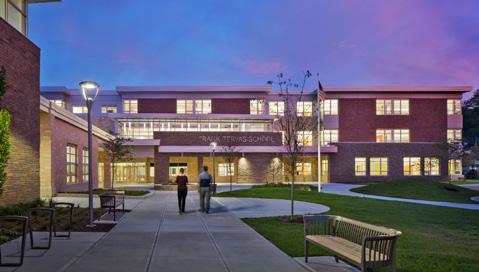
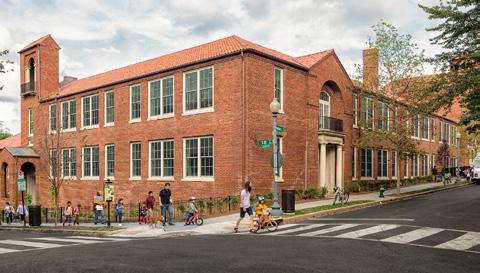
ASSISTED DROP-OFF/PICK-UPS
This example of an urban high school in Lowell, MA includes enlarged sidewalk zones for safe student circulation and cueing while arriving, departing, or waiting. The sidewalk zones also include ample planted and seat
GOOD VISIBILITY AND LIGHTING
Providing clear visibility throughout the site reduces the likelihood of accidents, and ensures that staff can easily monitor people as they approach the site and the building. Good lighting also improves safety for afterhours events such as community meetings or sports.
SAFE ROUTES TO SCHOOL
Coordinate with city or neighborhood
 Bancroft Elementary School | Washington, DC
Photo courtesy of District of Columbia Public Schools
Zervas Elementary School | Newton, MA Lowell High School | Lowell, MA
Bancroft Elementary School | Washington, DC
Photo courtesy of District of Columbia Public Schools
Zervas Elementary School | Newton, MA Lowell High School | Lowell, MA
18
Zervas Elementary School | Newton, MA
CREATE A POSITIVE AND CONNECTED SCHOOL CULTURE 2
Data shows that school climate and culture, including the way a school looks and is maintained, is a key way to prevent violence and bullying, and to keep a school safe. It also affects communication and the ability for students to be known, for issues and concerns to be understood, and for timely mitigation to occur when needed.
There are a number of ways educators and leaders can create a positive and connected culture. In terms of architectural design, two important tactics are to interweave informal learning spaces throughout the building, and to increase visibility by thoughtful placement of doors and interior windows. In our conversations with schools, the informal spaces outside the classroom were rated highly by teachers not only for their ability to engage academic discussion, but also to create a connected culture. Physical features such as arrangement and connectivity of spaces within a school facility can contribute significantly to a positive and connected culture. The images shown here are just a few examples.
EXAMPLES:
District:
▪ Personally greet all students daily
▪ Employ programs to empower, educate, and connect students
▪ Conduct student surveys or one-on-one time to detect isolation
▪ Follow good facility and site maintenance plan and procedures
Designer:
▪ Create warm, welcoming environments
▪ Provide for display of student work, and celebrate arts and culture
▪ Plan the school as small learning communities
▪ Disperse and integrate adult offices and spaces throughout the school to encourage interaction with students
▪ Include informal learning and socializing spaces
▪ Provide transparency and natural supervision
▪ Select low maintenance materials and finishes
Community:
▪ Plan events and programs that include the broader community such as adult-education, senior programs, etc.
▪ Encourage active parent groups, volunteers, and champion s

MORNING GREETING
A compelling and simple strategy revealed in our interviews and research is the use of morning greetings by teachers and school leaders to foster the connections between the school and students. Even in very large settings, such as Lowell High School with over 3,500 students, the act of having staff monitor and greet students at the various arrival points was seen as an effective means to connect and allow an informal read on behaviors.
Welcoming students at the door can increase academic engagement by 20% while decreasing disruptive behavior by 9%. 28
Ron Brown High School | Washington , DC
19 DESIGN FOR SAFE AND HEALTHY CHILDREN PERKINS EASTMAN
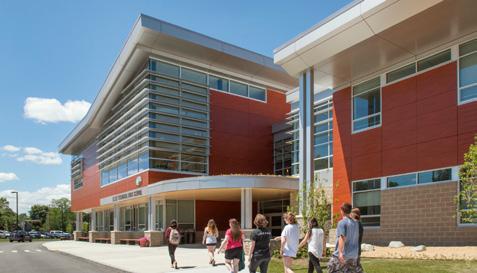


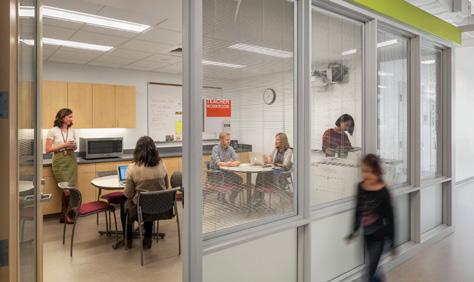
WELCOMING ENVIRONMENTS
A warm and welcoming entry, with sunlight and shade, greenery and hardscape including seat walls and lampposts, help set the tone upon arrival.
Windows and glazed storefrontstyle entrances are welcoming and approachable, and also help staff and administrators inside the building monitor who is approaching the building.
ARTWORK AND STUDENT DISPLAYS
Meaningful displays and experiential graphics are a powerful tool to support a school’s culture and help establish a sense of belonging and pride.
Permanent installations such as this example at Ron Brown High School in Washington, DC can provide community context and inspiration for students.
Providing spaces and features for displaying student work throughout the school gives students of all ages a sense of agency, belonging, and confidence.
SCHOOL CONNECTEDNESS
A survey of high school students found that “school connectedness” – a student’s feeling of being a part of and cared for at school – is key to reducing teenagers’ risk for engaging in risky behavior. The study also reported that students at schools with harsh discipline policies felt less safe than those at schools with more moderate policies.
Providing spaces for informal interaction among peers as well as students and staff help to build relationships and create positive connections.
HIGH VISIBILITY
Providing good visibility into student spaces throughout the school helps all occupants feel more comfortable and fosters connections and relationships among students and staff.
Good visibility throughout the building site and interior makes for a safer environment, reducing opportunities for bullying, harrassment, and abuse. The rarer these types of events are, the less likely a student or students are to feel isolated, and problems that do arise are less likely to escalate to larger events.
Ron Brown High School | Washington , DC
Essex Technical High School | Hathorne, MA
Martin Luther King, Jr School | Cambridge, MA
20
Martin Luther King, Jr School | Cambridge, MA
MENTAL HEALTH SUPPORT AND AWARENESS 3
The consistent theme across numerous surveys and studies is that mental health concerns are, by far, the highest risk and single biggest concern in our schools. The CDC’s National Youth Risk Behavior Survey (Figure 4) illustrates this, with “persistent feelings of sadness and hopelessness” at the top, as does our own regional survey results, with metal health concerns being ranked as the number one concern by a margin more than five times higher than any other. The solution begins by creating awareness, identifying students that struggle with mental health and social-emotional issues, and providing supports that include the whole school community as much as specialists.
According to the ACLU, “The benefits of investing in mental health services are clear: Schools with such services see improved attendance rates, better academic achievement, and higher graduation rates as well as lower rates of suspension, expulsion, and other disciplinary incidents. Data shows that the presence of school-based mental health providers not only improves outcomes for students, but can also improve overall school safety.” Shockingly, 14 million students are in schools with police but no counselor, nurse, psychologist, or social worker.29
Children need to learn how to act in ways that will empower them to keep themselves safe (e.g. practice drills). Psychologist Jana Martin states, “When children are given tools, that heightens their sense of security instead of them looking to outside measures to keep them safe.”30
In addition to support services, the physical environment can play a role in positively influencing behavior. Biophilic design not only connects people to nature, but acts as a calming measure, and helps to reduce stress by incorporating natural materials, light, views, vegetation, and other natural experiences. Creating a sense of calm and security within the school can counteract the chaos that may occur for students in their community or homes. This provides stability and helps children build positive relationships with adults and each other. The following images offer several examples.
EXAMPLES:
District:
▪ Provide counselors, psychologists, and other support staff at ratios appropriate to the student population
▪ Provide supplemental services for mental health needs
▪ Institute peer, ambassador, and other programs
▪ Teach students strategies to manage stress and anxiety (such as mindfulness, meditation, and exercise)
Designer:
▪ Incorporate Universal Design strategies (physical, cognitive, and social-emotional)
▪ Include biophilic design principles to help instill a sense of calm and reduce stress
▪ Provide dedicated space for support services and flexibility for growth or supplemental needs
▪ Position support spaces to encourage positive and casual interaction
Community:
▪ Institute community support programs (such as Big Brother/Big Sister)
▪ Conduct awareness campaigns around mental health and available resources

Cleveland Park Library | Washington, DC
21 DESIGN FOR SAFE AND HEALTHY CHILDREN PERKINS EASTMAN



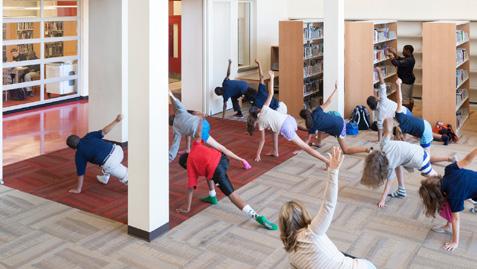
CREATING A SENSE OF BELONGING
Gathering spaces for large and small groups throughout the school can provide spaces for meaningful connection.
At Ron Brown High School, students gather daily for a morning meeting where all participate in sharing what’s going on in their life. This can also be done with smaller groups such as a grade level, team cluster, or single class.
BIOPHILIA
Research at the University of Illinois Landscape and Human Health Laboratory concluded that girls with views to greener, more natural views scored higher on tests of concentration and self-discipline, and that ADHD symptoms in children are relieved after spending time in nature - the greener the setting, the greater the relief.17
Biophilic elements include the use of natural colors, patterns, and direct visual connections to natural areas outside, among other things. The 14 Patterns of Biophilic Design, as established by Terrapin Bright Green, is a great resource on the topic. 31
DAYLIGHTING AND SCHOOLS
Many studies confirm the positive effects of daylight on mood, alertness, concentration, and improved learning outcomes.
Students in daylit classrooms progress faster on both reading and math tests.
Daylight and natural views can also reduce the symptoms of anxiety, and keep the body’s natural circadian rhythm in tune. An interrupted circadian rhythm can impact mental and psychological functioning.
STRESS MANAGEMENT
Incorporating time for students to talk about their day, to find calm, and to set expectations all contribute to raising awareness about mental health and reducing stigma. The better students are able to identify and communicate how they are feeling, the more likely they are to be able to manage those emotions or to seek help when needed.
Many schools offer programs such as yoga, seen here in the library at the Washington Latin school in Washington, DC.
Ron Brown High School | Washington , DC
Green Ivy Pine Street School | New York, NY
22
Martin Luther King, Jr School | Cambridge, MA Washington Latin Public Charter School | Washington, DC
BUILDING DESIGN, SYSTEMS, AND PLANNING FEATURES (Including CPTED) 4
This category of response to school safety has been mistakenly seen as virtually the entire focus for safety and security by some. It includes the very common and familiar components, such as perimeter protections, controlled access and locks, surveillance, and detection. It can include active components, such as camera systems, as well as passive measures, such as natural sightlines and visibility. Some aspects of building design could be taken to extremes or focused too narrowly on a single aspect of safety, causing unintended consequences or increasing other risks.
An example of this is the elimination of glass from corridors into rooms for the sake of keeping students and teachers out of sight. While the effectiveness of doing so is debatable itself, having windowless interior spaces increases the risk of bullying, assault, and abuse, all of which are far more probable threats than an intruder. Visibility and acoustic connections make students feel safe and improve safety by keeping people connected, fostering accountability, making unusual behaviors known, and even assisting first responders. A more appropriate response to concerns for keeping students out of sight might be designing rooms with glass, but creating a natural get-out-of-sight zone within the room, based on a design with sightlines factored in. The images shown here are just a few examples.
EXAMPLES:
District:
▪ Institute visitor access and control via interaction, security check, and badging systems
Designer:
▪ Define school territory and denote thresholds
▪ Incorporate natural building protections such as grading, landscaping, bollards, and mullions to impede access
▪ Plan for easy wayfinding and natural surveillance
▪ Design a clear and controlled entry allowing behavioral read of visitors before they are granted building access
▪ Plan for lock-off layers within the building allowing temporary lock-down or closure of some building zones
▪ Specify materials and finishes that are durable and easy to maintain
▪ Include natural out-of-sight zones or retreat areas for all spaces
▪ Provide auto-locking doors and don’t rely on blinds
Community:
▪ Create assisted surveillance programs, such as neighborhood watch
▪ Organize parent or community volunteering for assistance in campus maintenance such as outdoor gardens, clean-up events, or other beautification projects
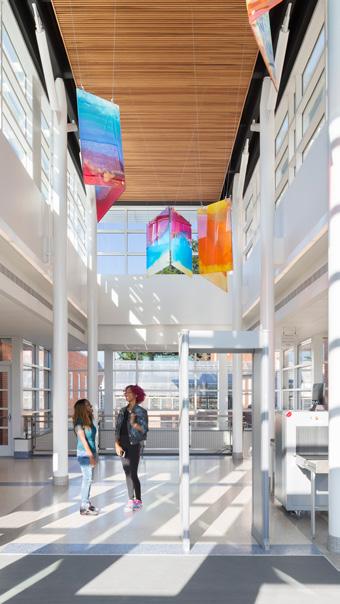
Roosevelt High School | Washington, DC 23 DESIGN FOR SAFE AND HEALTHY CHILDREN PERKINS EASTMAN
CRIME PREVENTION THROUGH ENVIRONMENTAL DESIGN (CPTED) FRAMEWORK
Crime Prevention Through Environmental Design (CPTED) is not a new concept, having origins that date back to the era of other design movements such as passive solar planning in the 1960’s. The architectural profession as a whole, however, seemed to have lost its way in the 1980’s and 1990’s, only to witness a resurgence to both these practices entering the 2000s.
The CPTED concept is rooted in the understanding that physical environments affect behavior and that proper planning for natural surveillance, access and controls, territorial reinforcement, and keeping properties clean and well maintained can deter crime and lead to safer environments. The modern CPTED framework includes these four areas:
1. Natural Surveillance – The design and placement of physical features in such a way as to maximize visibility and avoid auditory isolation. It includes the use of windows, placement of walkways, lighting, and a host of other design considerations to provide opportunities for casual surveillance. The objective is to eliminate hiding or hard-to-see places and to increase the perception of human presence or supervision.
2. Access & Controls – Access management is the physical guidance of people and vehicles coming and going from a place. Barriers, real or symbolic, prevent or discourage inappropriate access. The objectives are to guide people and vehicles to appropriate entrances and exits and to limit access where appropriate. Access controls include comprehensive wayfinding concepts, locking and entry mechanisms, visitor screening procedures, and holding vestibule strategies (useful for receiving as well as main entry protocols).
3. Territorial Reinforcement – Territoriality is the use of physical attributes to delineate space and express a positive sense of ownership. One objective is to increase a sense of pride and ownership by the students, staff, and community. People tend to care for and protect property they perceive as their own. Another objective is to indicate that a space is cared for and that unacceptable behavior will not be tolerated. In the ideal application of territoriality, all spaces have clearly defined boundaries, are designed for a particular purpose, and have defined caretaking.
4. Maintenance – Physical maintenance is the repair, replacement, and general upkeep of a space, building, or area. The objective is to allow for the continued use of a space for its intended purpose. An attractive and well-maintained environment shows respect for the students and staff that use the facility. The ease of maintenance for a facility and grounds should be a primary consideration during design.
As you can see from this list, there is some overlap of CPTED principles with other areas of our Balanced Approach presented in this paper. Natural Surveillance, Access & Controls, and Maintenance are all part of the physical design and planning features that should be considered when designing a school.
Ken Jenks, Assistant Superintendent of the Dennis-Yarmouth Regional School District in Massachusetts comments, “If you go to a place, and every door is closed and locked… you sort of wonder, ‘is this a prison’?”
Jenks agrees that locks and access control are really important, but also emphasized there has to be middle ground. And, he says, “With high visibility– including interior and exterior windows and cameras– it’s really hard to bully people.”
24
(Continued...) 4
BUILDING DESIGN, SYSTEMS, AND PLANNING FEATURES

DEFINE SCHOOL TERRITORY
Defining the boundaries of a school property is meant to signal to someone that they have crossed a threshold and not necessarily to build walls and barriers. The boundary signals deliberate crossing and accountability.
In this example, the perimeter is defined by a combination of fence, openings, and landscape buffers aimed at directing pedestrian circulation, improving supervision and signaling the extent of property.


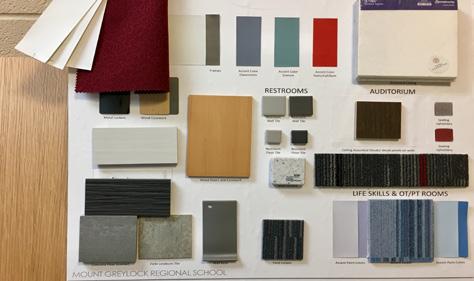
VISIBILITY & AUDIBIITY
High visibility throughout the school means there are “eyes on the street” at all locations, reducing the likelihood of bullying and other forms of harassment. This includes windows between classrooms, staff work areas, offices, and even mechanical spaces.
Audibility is also important, enabling staff and others to hear what is going on in an enclosed space. One common safety feature is the “airport style” toilet rooms. This maintains visual privacy but helps to reduce bullying since others can hear voices within. An added bonus is the improved sanitation of no doors to handle.
EASY MAINTENANCE
While good maintenance practices and funding are the district’s responsibility, the building design can assist greatly in material selection that require little or no maintenance. Likewise, the logistics for cleaning and maintaining must be factored in.
Some examples include dispersed and rightsized custodial closets with easily accessed storage, sinks, and charging outlets for equipment. It might also include easy access or proper equipment to change lighting or clean glass in tall spaces.
The following images illustrate several examples of building design, systems, and planning features.
Zervas Elementary School | Newton, MA Finish
board during design process
25 DESIGN FOR SAFE AND HEALTHY CHILDREN PERKINS EASTMAN
Rendering of airport style bathroom layout for an elementary school
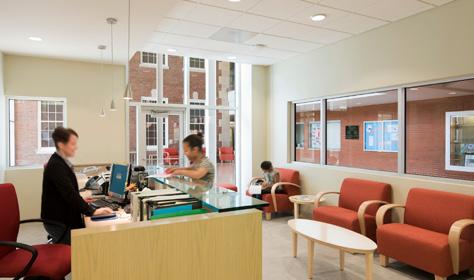
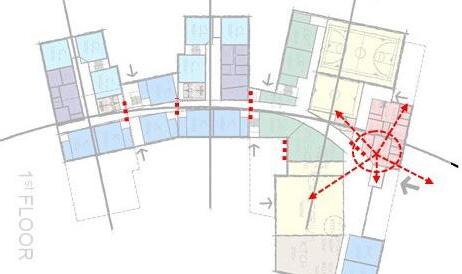
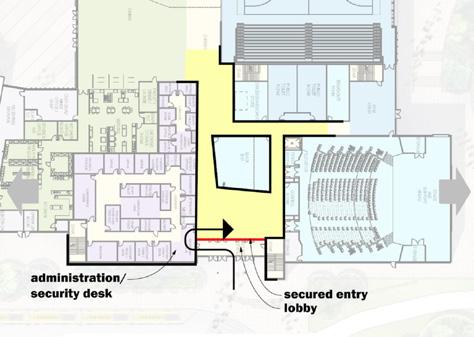
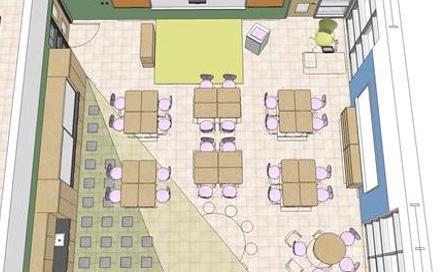
NATURAL SURVEILLANCE
Providing good visibility and easy natural surveillance both oustide and inside the school is a key feature for safety.
Open and visible sites with ample windows to the outdoors not only provide important natural views, but also allow occupants to see what’s going on outside.
On the interior of the building, open corridors and clear sight lines help people navigate the building easily, and simplify supervision for the staff.
LOCK-OFF LEVELS
In addition to secure exterior doors and a controlled entry, schools should be planned with lockable layers, enabling compartmentalization, to allow controlled access from zone to zone should the need arise.
This example shows the plan of a school with a zone for large activity programs and heavy after-hours use, while the academic wings are able to be closed off incrementally.
CONTROLLED MAIN ENTRY
Providing a single point of entrance to a school ensures that all visitors are greeted and checked in before entering the school. Best practices include a security vestibule with both “layers” of entrance doors locked.
A doorbell or video phone allows requests to enter the vestibule. Then visitors must enter a welcome center for official check-in with administration before being allowed access to the rest of the school.
OUT-OF-SIGHT ZONE
This diagram of a classroom floor plan illustrates a safe classroom with a natural get-out-of-sight area – indicated as a green triangle – as well as ample glass and visibility to the corridor, to the neighboring room, and to the outdoors.
In this example from Zervas Elementary School in Massachusetts, the actual rooms include a change in floor pattern to signify the out-of-sight zone to students and staff, making it easy to practice drills.
Zervas Elementary School | Newton, MA
26
Stoddert Elementary School | Washington, DC
SAFETY POLICY, INTEGRITY, AND PREPAREDNESS 5
Even the most secure facility can be rendered vulnerable if policies are not in place or followed consistently. Each school facility should have site-specific policies and protocols, but enforcement is equally important to be sure the policies have integrity. Some classic examples of how policies are compromised, even with good intentions, are if students or teachers hold a door open out of kindness to a visitor, or if a door is wedged open out of convenience for major deliveries or large groups entering.
Current best practices dictate the establishment of threat assessment teams and ongoing review of policies and procedures to ensure practices stay current and responsive to evolving conditions. The composition of the team is also important and should include custodial, maintenance, kitchen, and transportation leadership. We are also seeing the need for new and varied drills to best prepare students and staff, including reverse evacuation and medical emergencies. The following images offer several examples.
EXAMPLES:
District:
▪ Ensure policies have integrity; no holding doors for strangers or pegging them open during deliveries or other in/out conveniences
▪ Establish threat assessment teams that are continuously reviewing behaviors and policies
▪ Conduct surveys to better understand bullying, gang, and drug activity, and other behavioral issues within the student body
▪ Practice supplemental drills (such as reverse evacuation, medical emergency, room clear, and where to go). Practice calm, but deliberate actions.
▪ Provide training for all school personnel in behavioral detection and de-escalation
Community:
▪ Coordinate communication and training with local emergency personnel (police, fire, first aid)
▪ Educate the community, including parents and neighbors, about policies so that they understand intent and can follow and enforce them

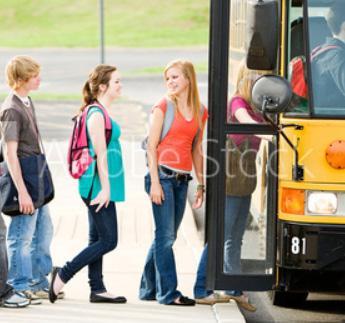
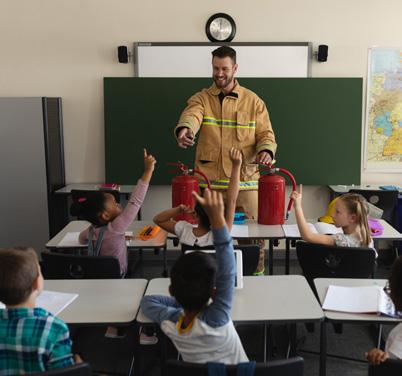
TRAINING STUDENTS & PERSONNEL
Providing training for both staff and students ensures their preparedness and readiness to follow and enforce school policies, as well as respond to incidents as they happen.
Quality training helps everyone to feel more confident and able to respond calmly in emergency situations.
27 DESIGN FOR SAFE AND HEALTHY CHILDREN PERKINS EASTMAN
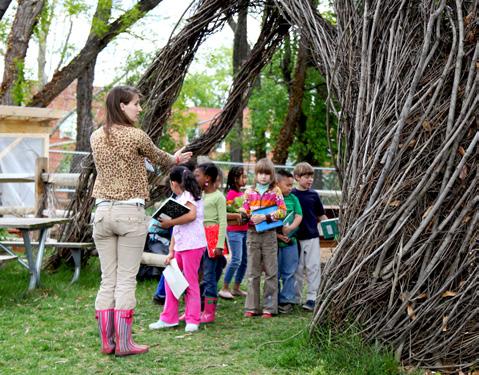
SUPPLEMENTAL DRILLS
Many sources, including the Sandy Hook Advisory Commission and Safe Havens International, emphasize the importance of other drills and training beyond fire and lockdown.
Some of these include reverse evacuation, shelter-in-place, and room clear. Training and practice in these protocols can ensure the safety of students and staff in case of external threats such as severe weather, utility failures, or hazardous material spills. Fire service and emergency management personnel can assist school officials in developing these protocols and training processes.



SCHOOL POLICIES
Ensuring that all staff, students, and visitors are aware of school policies is of utmost importance.
Beyond just awareness, it is equally critical that policies are honored and enforced. Seemingly harmless actions, such as propping open a door or disabling automatic closers or locks, can create unintended breaches in the safety of the entire school.
THREAT ASSESSMENT TEAMS
Threat Assessment teams include school leadership and staff as well as mental health professionals and community partners, such as fire or law enforcement officers.
Threat assessment emphasizes early attention to problems such as bullying, teasing, or other forms of conflict before they escalate into violent behavior.
School staff adopt a flexible problemsolving approach to investigate and resolve reported threats.
A recommended resource for practical procedures and training is the Comprehensive School Threat Assessment Guidelines manual created by experts at the UVA Curry School.
28
Stoddert Elementary School | Washington, DC
CONCLUSION
Though statistically infrequent compared to everyday issues like vehicular accidents or verbal bullying, the many frightening and heartbreaking incidents of violence at schools across the country has communities on edge. As school leaders do their best to address concerns and prepare for the unknown, the research illustrates that a comprehensive approach is critical to success.
Feeling safe at school translates into higher academic achievement, increased student well-being, and greater engagement. Students who don’t feel safe are unable to concentrate on their studies, have trouble connecting with classmates or teachers, and sometimes don’t attend school at all. Further, students who don’t get sufficient or timely socio-emotional support will not only struggle, but will be more likely to cause self-harm or become the very ones causing harm to others.
By studying the public health approach, we understand that it is far more effective to address the underlying challenges and work on prevention. Systemwide policies that support all students and staff in positive ways benefit everyone and can prevent more severe behavioral challenges and violence.
The solution requires an expanded definition of wellbeing to include cognitive and emotional health, in addition to physical wellness. When schools and communities nurture the whole child, considering all aspects of well-being (including meaning, belonging, mindfulness, and vitality,) schools will be intrinsically safer places.
It is important that all parties understand the underlying issues and challenges that lead to violence,
and are able to communicate these challenges to the community, including parents, neighbors, fire inspectors, police, and others. Architecture and design of school facilities certainly has an important role to play in creating safe schools but, as the research shows, challenges cannot be solved by architecture alone. The solutions will require the participation and cooperation of everyone in the community.
We all want what is best for children, but lack of knowledge about the impact of various choices can lead to harmful results. Thus, education about mental health, public health strategies, and the holistic needs of students need to be prioritized.
As the categories of the Balanced Approach illustrate, all schools and districts can implement policies, improve training protocols, and improve communications to significantly increase safety and student well-being. Many of these improvements can be done without making any physical changes or capital investment. When it does come time to make investments in renovations or replacements of school facilities, there are many additional factors that can easily be incorporated.
At Perkins Eastman, we specialize in designing high performance schools. With the research that went into this paper, we have a deeper understanding of the importance of a public health approach. We hope that those reading this paper also feel inspired to use this knowledge to create positive change in the lives of children everywhere. As school designers, district leaders and members of the community, we can all play a roll in making our schools safe and healthy.

29 DESIGN FOR SAFE AND HEALTHY CHILDREN PERKINS EASTMAN
It is critical to understand that everyone, in each facet of society, can contribute to creating safe school communities, and must participate to be a part of the solution.
CONTACT US
If you would like to discuss the results of this research study, please contact one of the research team members listed below. We are also available to present these findings and industry trends to your organization’s leadership and Board.
RESEARCH TEAM:
Ann Neeriemer, AIA, LEED AP Senior Associate
a.neeriemer@perkinse astman.com
202.212.6057
Robert Bell , AIA, ALEP, LEED BD+C Co-Managing Principal r.bell@perkinseastman.com
617.712.2115
CONTRIBUTORS:
Emily Chmielewski , EDAC Senior Associate | Design Research Director e.chmielewski@perkinse astman.com
412.894.8366
PHOTOGRAPHY:
K12 LEADERSHIP:
Sean O’Donnell , FAIA LEED AP Principal | K12 Practice Area Leader
s.odonnell@perkinse astman.com
202.384.1885
MARKETING:
Kerrie Frymire, CPSM Senior Associate | K12 Marketing Specialist
k.frymire@perkinse astman.com
202.212.6051
Copyright Joseph Romeo (pgs. 14, 21, 22, 23, 26), Copyright Paúl Rivera (pg. 22),
Copyright Robert Benson (pg. 4), Copyright Chris Cooper (pg. 17), and
Copyright Peter Vanderwarker (pg. 20),
Photo courtesy of District of Columbia Public Schools (pg. 18)
Copyright Adobe Stock (pgs. 27, 28),
Copyright Sarah Mechling-Perkins Eastman, Andrew Rugge-Perkins Eastman or Peter Jakubowski-Perkins Eastman (all remaining images)
30
ENDNOTES
1 J. Stephen C. Satterly, “Report of Relative Risks of Death in U.S. k-12 Schools,” Safe havens International.
2 (NHTSA), National Highway Traffic Safety Administration, “School-transportation-related crases: 20062015 data,” National Center for Statistics and Analysis, Washington DC, 2017.
3 Curry School of Education and Human Development, “School Violence Myths,” University of Virginia , 26 July 2015. [Online]. Available: https://curry.virginia.edu/faculty-research/ centers-labs-projects/research-labs/youth-violence-project/ violence-schools-and-5. [Accessed 2018].
4 Sanchez, “What Decades of School Shootings Has Taught Me,” NPR, 22 February 2018. [Online]. Available: https:// www.npr.org/sections/ed/2018/02/22/587334597/whatdecades-of-covering-school-shootings-has-taught-me.
5 Center for Disease Control and Prevention, “Youth Risk Behavior Survey,” Washington DC, 2017.
6 E. C. D. &. H. F. Nekvasil, “ Prevalence and offense characteristics of multiple casualty homicides: Are schools at higher risk than other locations? Psychology of Violence, 5, 236245,” 2015.
7 D. Ropeik, School shootings are extraordinarily rare. Why is fear of them driving policy?, Washington Post, 2018.
8 World Health Organization, [Online]. Available: www.who.int/ features/factfiles/mental_health/en.
9 Centers for Disease Control and Prevention (CDC), “Adverse Childhood Experiences,” [Online]. Available: https://www. cdc.gov/violenceprevention/childabuseandneglect/acestudy/index.html?CDC_AA_refVal=https%3A%2F%2Fwww. cdc.gov%2Fviolenceprevention%2Facestudy%2Findex.html. [Accessed 10 May 2020].
10 C. Turner, “What Do Asthma, Heart Disease, and Cancer Have in Common? Maybe Childhood Trauma,” NPR Weekend Edition, 23 January 2018. [Online]. Available: https://www. npr.org/sections/ed/2018/01/23/578280721/what-doasthma-heart-disease-and-cancer-have-in-common-maybechildhood-trauma. [Accessed 12 June 2020].
11 A. Kamenetz, “How to Apply the Brain Science of Resilience to the Classroom,” NPR, 12 June 2017. [Online]. Available: https://www.npr.org/sections/ ed/2017/06/12/530893427/how-to-apply-the-brainscience-of-resilience-to-the-classroom. [Accessed 12 June 2020].
12 C. W. a. K. Jenks, Interviewee, [Interview]. 2019.
13 A. &. F.-H. C. D. &. P. L. Milam, “Perceived School and Neighborhood Safety, Neighborhood Violence and Academic Achievement in Urban School Children,” The Urban review, vol. 42, pp. 458-467, 2010.
14 Association for Supervision and Curriculum Development, “Whole Child Education,” [Online]. Available: http://wholechildeducation.org/about/
15 J. Hari, Lost Connections: Uncovering the Real Causes of Depression - and the Unexpected Solutions, Bloomsbury, 2018.
16 R. Chatterjee, “School Shooters: What’s Their Path To Violence?,” NPR, 10 February 2019. [Online]. Available: https://www.npr.org/sections/healthshots/2019/02/10/690372199/school-shooters-whatstheir-path-to-violence. [Accessed 12 June 2020].
17 R. Louv, Last Child in the Woods: Saving Our Children from Nature-Deficit Disorder, Chapel Hill: Algonquin Books, 2008.
18 Mcewen, Bruce. (2007). Physiology and Neurobiology of Stress and Adaptation: Central Role of the Brain. Physiological reviews. 87. 873-904. 10.1152/physrev.00041.2006.
19 Associated Press, “School safety: Are costly high-tech gadgets the answer?,” 2 October 2018. [Online]. Available: www.heraldtribune.com. [Accessed June 2020].
20 M. Nadine Burke Harris, The Deepest Well: Healing the Long-Term Effects of Childhood Adversity, Houghton Mifflin Harcourt, 2018.
21 FitzGerald, “Mental Health Experts Warn Schools About Armed Staff,” Newtimes, 17 February 2013.
22 American Public Health Association, “Violence is a Public Health Issue: Public Health is Essential to Understanding and Treating Violence in the U.S.,” 13 November 2018. [Online]. Available: https://www.apha.org/policies-and-advocacy/public-health-policy-statements/policy-database/2019/01/28/violence-is-a-public-health-issue. [Accessed 19 June 2020].
23 Interdisciplinary Group on Preventing School and Community Violence, “Call for Action to Prevent Gun Violence in the United States of America,” Curry School of Education and Human Development, 28 February 2018. [Online]. Available: https://curry.virginia.edu/prevent-gun-violence.
24 L. Maxwell, “School building condition, social climate, student attendance and academic achievement: A mediation model,” Journal of Environmental Psychology, p. 46, 2016.
25 Sandy Hook Advisory Commission, “Final Report of the Sandy Hook Advisory Commission,” Sandy Hook, CT, 2015.
26 Gaggle, “2018-19 Gaggle Student Safety Report,” 2019. [Online]. Available: gaggle.net. [Accessed 28 February 2020].
27 L. M. a. A. Wise, “WAMU Guns & America: Gunshots and Lockdowns: When Nearby Gun Violence Interrupts the School Day,” 17 June 2019. [Online]. Available: https:// gunsandamerica.org/story/19/06/17/gunshots-and-lockdowns-when-nearby-gun-violence-interrupts-the-school-day/. [Accessed June 2019].
28 Cook, Fiat, Larson. 2018.
29 American Civil Liberties Union, “Cops and No Counselors: How the Lack of School Mental Health Staff is Harming Students,” 2019. [Online]. Available: https://www.aclu.org/ sites/default/files/field_document/030419-acluschooldisciplinereport.pdf. [Accessed 10 March 2020].
30 FitzGerald, “Mental Health Experts Warn Schools About Armed Staff,” Newtimes, 17 February 2013.
31 http://www.terrapinbrightgreen.com/wp-content/uploads/2014/04/14-Patterns-of-Biophilic-Design-Terrapin-2014e.pdf
BOSTON
CHARLOTTE
CHICAGO
COSTA MESA
DALLAS
DUBAI
GUAYAQUIL
LOS ANGELES
MUMBAI
NEW YORK
OAKLAND
PITTSBURGH
RALEIGH
SAN FRANCISCO
SHANGHAI
STAMFORD
TORONTO
WASHINGTON DC
WWW.PERKINSEASTMAN.COM


 Stoddert Elementary School | Washington, DC
Stoddert Elementary School | Washington, DC

















 Bancroft Elementary School | Washington, DC
Photo courtesy of District of Columbia Public Schools
Zervas Elementary School | Newton, MA Lowell High School | Lowell, MA
Bancroft Elementary School | Washington, DC
Photo courtesy of District of Columbia Public Schools
Zervas Elementary School | Newton, MA Lowell High School | Lowell, MA


























